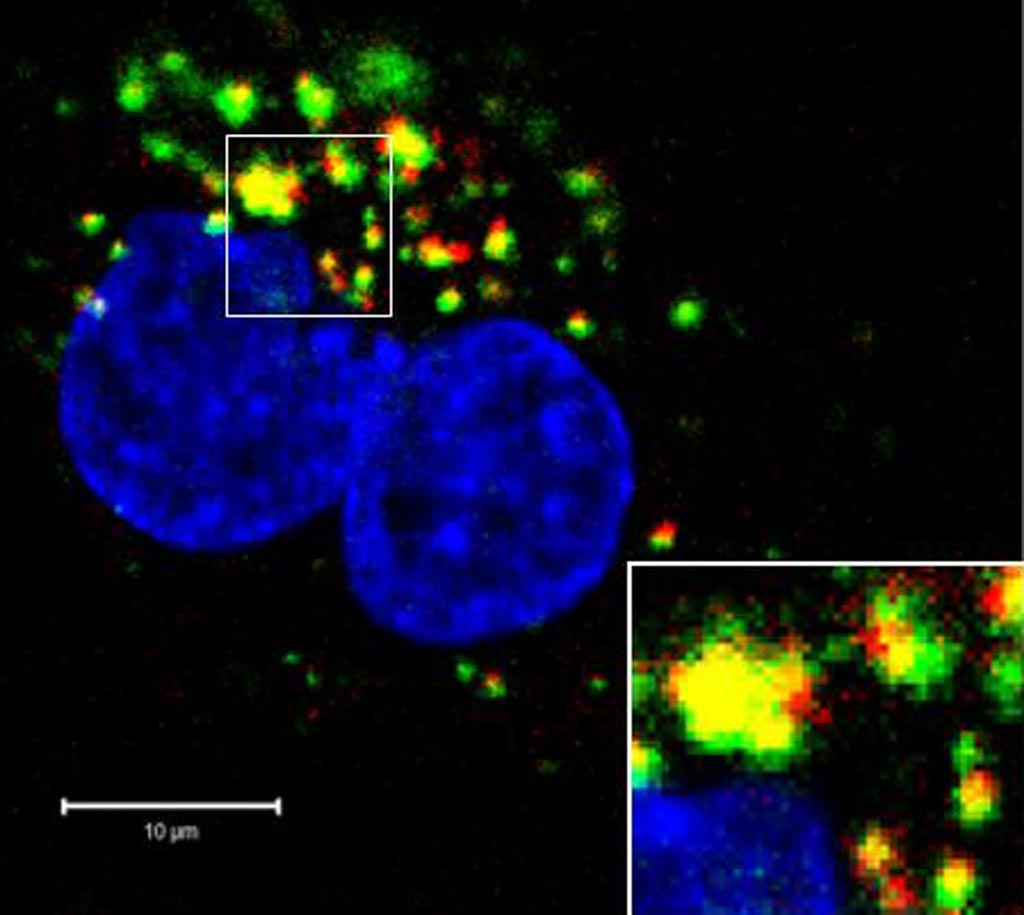Antisense DNA Drug Cures Prostate Cancer in Model
By LabMedica International staff writers
Posted on 31 Oct 2018
A team of cancer researchers has developed a novel oligonucleotide drug that destroys prostate tumors by overcoming tumor immune tolerance and activating the antitumor immune response.Posted on 31 Oct 2018
Investigators at City of Hope (Duarte, CA, USA) recently described a novel strategy combining STAT3 (signal transducer and activator of transcription 3) inhibition with TLR9 (Toll-like receptor 9) stimulation to activate the immune response against prostate cancers regardless of the tumor's genetic background.

Image: A micrograph showing a DNA drug (CpG-STAT3 antisense, red) penetrating human prostate cancer cells within 15 minutes of exposure (CpG-STAT3 antisense, red; intracellular vesicles, green) (Photo courtesy of City of Hope).
STAT3 is a member of the STAT protein family, which regulates many aspects of cell growth, survival, and differentiation. Malfunction of this signaling pathway is frequently observed in primary tumors and leads to increased angiogenesis and enhanced tumor survival. Knockout studies have provided evidence that STAT proteins are involved in the development and function of the immune system and play a role in maintaining immune tolerance and tumor surveillance. Constitutive STAT3 activation is associated with various human cancers and commonly suggests poor prognosis. Toll-like receptors (TLRs) comprise a family of proteins on the surface of immune cells that recognize molecules released by pathogens or damaged cells and then initiate an appropriate immune response.
To accomplish the dual task of activation and suppression, the investigators synthesized the antisense DNA oligonucleotide drug CpG-STAT3ASO. CpG oligodeoxynucleotides (or CpG ODN) are short single-stranded synthetic DNA molecules that contain a cytosine triphosphate deoxynucleotide ("C") followed by a guanine triphosphate deoxynucleotide ("G"). The "p" refers to the phosphodiester link between consecutive nucleotides. When these CpG motifs are unmethylated, they act as immunostimulants. TLR9 is usually activated by unmethylated CpG sequences in DNA molecules. Once activated, TLR9 moves from the endoplasmic reticulum to the Golgi apparatus and lysosomes, where it interacts with MyD88, the primary protein in its signaling pathway. TLR9 is cleaved at this stage to avoid whole protein expression on cell surface, which could lead to autoimmunity.
The investigators reported in the October 18, 2018, online edition of the journal Clinical Cancer Research that systemic administration of CpG-STAT3ASO eradicated bone-localized prostate tumors in the majority of treated mice. These antitumor effects were primarily immune-mediated and correlated with an increased ratio of CD8+ to regulatory T-cells. Both innate and adaptive immunity contributed to systemic antitumor responses. Therefore, the concurrence of TLR9 activation with STAT3 inhibition in the same cellular compartment was indispensable for overcoming tumor immune tolerance and effective antitumor immunity against prostate cancer.
"We desperately need new strategies for late-stage prostate cancers, which thus far have resisted emerging immunotherapies," said senior author Dr. Marcin Kortylewski, associate professor of oncology at City of Hope. "It is clear that in this case, we need smart immunotherapies that can outmaneuver wily cancers. Our strategy relies on two opposite actions of the same "hot and cold" molecule. We fire up the immune system to attack and freeze tumor defenses. The combined effect of such a dual-function drug can remove obstacles to treating the most challenging solid tumors. It is possible that this DNA molecule could be used in the future for therapeutic vaccination against metastatic prostate cancer. Such an agnostic and off-the-shelf approach could work regardless of the genetics of an individual's prostate cancer. But more preclinical research on the pharmacologic properties of these new drugs is needed to get there."
Related Links:
City of Hope













